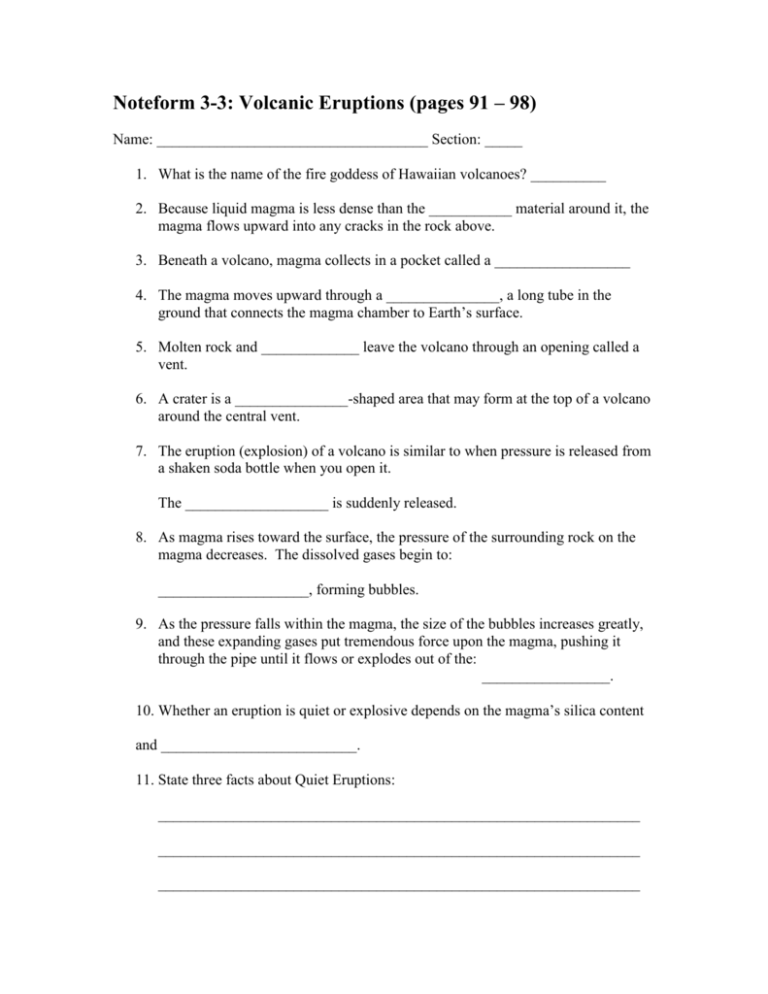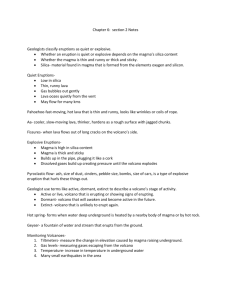Noteform 3-1: Volcanoes and Plate Tectonics (pages 82 – 85)
advertisement

Noteform 3-3: Volcanic Eruptions (pages 91 – 98) Name: ____________________________________ Section: _____ 1. What is the name of the fire goddess of Hawaiian volcanoes? __________ 2. Because liquid magma is less dense than the ___________ material around it, the magma flows upward into any cracks in the rock above. 3. Beneath a volcano, magma collects in a pocket called a __________________ 4. The magma moves upward through a _______________, a long tube in the ground that connects the magma chamber to Earth’s surface. 5. Molten rock and _____________ leave the volcano through an opening called a vent. 6. A crater is a _______________-shaped area that may form at the top of a volcano around the central vent. 7. The eruption (explosion) of a volcano is similar to when pressure is released from a shaken soda bottle when you open it. The ___________________ is suddenly released. 8. As magma rises toward the surface, the pressure of the surrounding rock on the magma decreases. The dissolved gases begin to: ____________________, forming bubbles. 9. As the pressure falls within the magma, the size of the bubbles increases greatly, and these expanding gases put tremendous force upon the magma, pushing it through the pipe until it flows or explodes out of the: _________________. 10. Whether an eruption is quiet or explosive depends on the magma’s silica content and __________________________. 11. State three facts about Quiet Eruptions: ________________________________________________________________ ________________________________________________________________ ________________________________________________________________ 12. State three facts about Explosive Eruptions: _________________________________________________________________ _________________________________________________________________ _________________________________________________________________ 13. Define ash: _______________________________________________________ 14. Define cinder: _____________________________________________________ 15. Define volcanic bomb: ______________________________________________ 16. Define pyroclastic flow: _____________________________________________ __________________________________________________________________ 17. How does obsidian (volcanic glass) form? _______________________________ _________________________________________________________________ 18. How does pumice (the only rock that can float in water) form? ______________ _________________________________________________________________ 19. Name two volcano hazards that are associated with quiet eruptions: _________________________________________________________________ _________________________________________________________________ 20. Name two hazards that are associated with explosive eruptions: __________________________________________________________________ __________________________________________________________________ 21. Examine and read the timeline of some major volcanoes within the past 150 years. Guess which volcano listed in the timeline was the deadliest. _________________ 22. The activity of a volcano may last from less than a decade to more than 10 million years. The life cycle of a volcano is described in three different stages, which are active, dormant or extinct. Which types will never erupt again: _______________ 23. Which life stage of a volcano can be described like a hibernating (sleeping) bear? __________________________ 24. Which life stage of a volcano is the live, erupting stage: ___________________ 25. Geologists have been more successful in predicting volcanic eruptions than in predicting earthquakes. Instruments can detect changes in a volcano and can give warning that it is in danger of erupting. List four things that geologists look for as danger signs of a coming eruption: A) _____________________________________________________________ _____________________________________________________________ B) _____________________________________________________________ _____________________________________________________________ C) _____________________________________________________________ _____________________________________________________________ D) _____________________________________________________________ _____________________________________________________________








